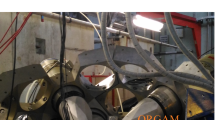Abstract.
Inverse kinematics is a new tool to study nuclear fission. Its main advantage is the possibility to measure with an unmatched resolution the atomic number of fission fragments, leading to new observables in the properties of fission-fragment distributions. In addition to the resolution improvement, the study of fission based on nuclear collisions in inverse kinematics beneficiates from a larger view with respect to the neutron-induced fission, as in a single experiment the number of fissioning systems and the excitation energy range are widden. With the use of spectrometers, mass and kinetic-energy distributions may now be investigated as a function of the proton and neutron number sharing. The production of fissioning nuclei in transfer reactions allows studying the isotopic yields of fission fragments as a function of the excitation energy. The higher excitation energy resulting in the fusion reaction leading to the compound nucleus 250Cf at an excitation energy of 45MeV is also presented. With the use of inverse kinematics, the charge polarisation of fragments at scission is now revealed with high precision, and it is shown that it cannot be neglected, even at higher excitation energies. In addition, the kinematical properties of the fragments inform on the deformation configuration at scission.
Similar content being viewed by others
References
J.P. Unik, J.E. Gindler, L.E. Glendenin, K.F. Flynn, A. Gorski, R.K. Sjoblom, in Proceedings of the Symposium on the Physics and Chemistry of Fission (IAEA Vienna, Rochester, 1973) 19
B.D. Wilkins, E.P. Steinberg, R.R. Chasman, Phys. Rev. 14, 1832 (1976)
J.-P. Bocquet, R. Brissot, H.R. Faust, M. Fowler, J. Wilhelmy, M. Asghar, M. Djebara, Nucl. Phys. A 502, 213 (1989)
C. Schmitt et al., Nucl. Phys. A 430, 21 (1984)
W. Lang, H.-G. Clerc, H. Wohlfarth, H. Schrader, K.-H. Schmidt, Nucl. Phys. A 345, 34 (1980)
I. Tsekhanovich et al., Nucl. Phys. A 688, 633 (2001)
A. Bail et al., Phys. Rev. C 84, 034605 (2011)
J. Randrup, P. Möller, Phys. Rev. C 88, 064606 (2013)
P. Talou, B. Becker, T. Kawano, M.B. Chadwick, Y. Danon, Phys. Rev. C 83, 064612 (2011)
O. Litaize, O. Serot, Phys. Rev. C 82, 054616 (2010)
K.-H. Schmidt, B. Jurado, Ch. Amouroux, JEFF Report 24, NEA Data Bank of the OECD (2014)
J.-F. Lemaitre, S. Panebianco, J.-L. Sida, S. Hilaire, S. Heinrich, Phys. Rev. C 92, 034617 (2015)
N. Dubray, H. Goutte, J.-P. Delaroche, Phys. Rev. C 77, 014310 (2008)
M. Bernas et al., Nucl. Phys. A 616, 352c (1997)
H. Geissel et al., Nucl. Instrum. Methods A 364, 150 (1992)
K.-H. Schmidt et al., Nucl. Phys. A 665, 221 (2000)
C. Böcktiegel et al., Nucl. Phys. A 802, 12 (2008)
S. Steinhäuser et al., Nucl. Phys. A 634, 89 (1998)
J.F. Martin, these proceedings
M. Caamaño et al., Phys. Rev. C 88, 024605 (2013)
C. Rodríguez-Tajes et al., Phys. Rev. C 89, 024614 (2014)
H. Savajols et al., Nucl. Instrum. Methods B 204, 146 (2003)
S. Pullanhiotan, M. Rejmund, A. Navin, W. Mittig, S. Bhattacharyya, Nucl. Instrum. Methods A 593, 343 (2008)
M. Rejmund et al., Nucl. Instrum. Methods A 646, 184 (2011)
Y. Alhassid, R.D. Levine, J.S. Karp, S.G. Steadman, Phys. Rev. C 20, 1789 (1979)
Olivier Delaune, Technique de la cinématique inverse pour l’étude des rendements isotopiques des fragments de fission aux énergies GANIL, Physique Nucléaire Expérimentale [nucl-ex] (Université de Caen, 2012) https://tel.archives-ouvertes.fr/tel-00757425/
R. Müller, A.A. Naqvi, F. Käppeler, F. Dickman, Phys. Rev. C 29, 885 (1984)
M. Caamaño, F. Farget, Phys. Proc. 64, 114 (2015) Scientific Workshop on Nuclear Fission dynamics and the Emission of Prompt Neutrons and Gamma Rays, THEORY-3
A.A. Naqvi, F. Käppeler, F. Dickmann, R. Müller, Phys. Rev. C 34, 218 (1986)
K.-H. Schmidt, B. Jurado, Phys. Rev. Lett. 104, 212501 (2010)
W.D. Myers, W.J. Swiatecki, Ark. Fys. 36, 343 (1967)
C. Tsuchiya et al., J. Nucl. Sci. Tech. 37, 941 (2000)
E.M. Kozulin, Proc. of FUSION06: Reaction Mechanisms and Nuclear Structure at the Coulomb Barrier, Vol. 853 (AIP Press, Venise, Italy, 2006) p. 366
Author information
Authors and Affiliations
Corresponding author
Additional information
Communicated by N. Alamanos
Rights and permissions
About this article
Cite this article
Farget, F., Caamaño, M., Ramos, D. et al. Transfer-induced fission in inverse kinematics: Impact on experimental and evaluated nuclear data bases. Eur. Phys. J. A 51, 175 (2015). https://doi.org/10.1140/epja/i2015-15175-y
Received:
Accepted:
Published:
DOI: https://doi.org/10.1140/epja/i2015-15175-y




